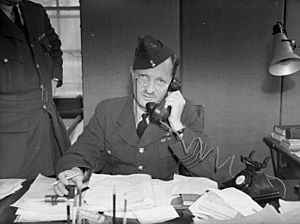Alfred Woodhall facts for kids
Quick facts for kids
Alfred Woodhall
|
|
|---|---|

Woodhall at his desk at Duxford, September 1940
|
|
| Nickname(s) | Woody |
| Born | 9 January 1897 Kirkby-in-Furness, United Kingdom |
| Died | 11 June 1968 (aged 71) Dunedin, New Zealand |
| Allegiance | United Kingdom |
| Service/ |
Royal Marines (1914–1925) Royal Air Force (1925–1945) |
| Rank | Group Captain |
| Battles/wars | First World War |
| Awards | Officer of the Order of the British Empire Mention in despatches (twice) Legion of Merit (United States) War Cross (Czechoslovakia) |
Group Captain Alfred Basil Woodhall (9 January 1897 – 11 June 1968) was a brave British officer. He served in the Royal Air Force (RAF) during the Second World War. He played a very important role in two major battles: the Battle of Britain and the Siege of Malta.
Born in Kirkby-in-Furness, Woodhall joined the Royal Marines at the start of the First World War. He fought on the Western Front in France. After being injured, he spent the rest of the war at sea. Later, he became a pilot in the Fleet Air Arm, flying torpedo bombers from aircraft carriers.
In 1930, he joined the RAF permanently. During the Second World War, he became a senior controller. This meant he guided fighter planes from the ground. He was known by his nickname, 'Woody'. He retired from the RAF in 1945 and later worked in aviation in New Zealand. He passed away at age 71.
Contents
Early Life and First World War Service
Alfred Basil Woodhall was born on January 9, 1897, in Kirkby-in-Furness, United Kingdom. He went to Bolton Grammar School. Later, he moved to South Africa and trained to be a mining engineer. When the First World War began, he sailed back to the UK to join the war effort.
Woodhall joined the Royal Marines as a second lieutenant. After his training, he went to the Western Front in France. He fought in the Battle of the Ancre in November 1916. During this battle, he was injured in his back and had to go to the hospital.
After he recovered, he was promoted to lieutenant in January 1917. He then served at sea with the Royal Navy. By the end of the war, he was on the battleship HMS Agincourt. He was there when the German fleet surrendered in November 1918.
Becoming a Pilot and Joining the RAF
After the First World War, Woodhall stayed in the Royal Marines. He served in the Far East aboard HMS Hawkins. In 1925, he volunteered to train as a pilot for the Fleet Air Arm (FAA). This meant he would fly planes from ships.
He started his flight training at Netheravon. In August, he earned his pilot's wings. He then joined a squadron that flew torpedo bombers. These planes launched torpedoes at enemy ships. He served on aircraft carriers like HMS Eagle and HMS Courageous.
Woodhall was very skilled at landing planes on carriers. He made over 100 perfect landings. This earned him a spot in the special 'Perch Club'. In July 1929, he was promoted to flight lieutenant.
He wanted to keep flying, so he joined the Royal Air Force (RAF) permanently in 1930. He first flew fighter planes. Later, he became a test pilot, trying out new aircraft. He also served overseas in places like Aden and Hong Kong. In 1938, he had to stop flying due to minor eye problems.
Second World War Contributions
In 1939, Woodhall was working at Duxford. He helped create a system to track enemy planes. This system was very important for guiding RAF fighters.
Battle of Britain Hero
In January 1940, Woodhall was promoted to wing commander. Three months later, he became the commander at Duxford. He was also the main controller for No. 12 Group. His job was to direct RAF fighters to stop incoming German Luftwaffe bombing raids.
His instructions were vital for placing RAF fighters in the best position to attack. Pilots knew his voice over the radio and called him 'Woody'. He supported the idea of the "Big Wing" formation, where many fighters flew together. For his service, he was awarded the Czechoslovak War Cross in January 1941. He was also made an Officer in the Order of the British Empire in March 1941.
Defending Malta
After the Battle of Britain, Woodhall was promoted to group captain. He took command of the RAF station at Tangmere. He continued to direct fighter operations.
In early 1942, Woodhall was sent to the island of Malta. Malta was under a heavy aerial siege by German and Italian forces. It needed an experienced fighter controller. He had very few planes, only seven Hawker Hurricanes when he arrived. He quickly set up a system to use these limited resources effectively.
Just like in the Battle of Britain, Woodhall used radar and observer reports to guide RAF pilots. He helped them get into the best position to intercept enemy bombers. Pilots said hearing his voice on the radio boosted their morale. By mid-1942, more Supermarine Spitfire fighters arrived, improving the situation. Woodhall then returned to the United Kingdom.
Later War Service and Retirement
Back in the UK, Woodhall worked at Fighter Command headquarters. In 1944, he went to Italy. There, he commanded a special unit that supplied resistance movements in Europe. He was recognized for his bravery twice. He also received an American award, the Legion of Merit.
Woodhall retired from the RAF in July 1945. After the war, he moved his family to Canada, and then to New Zealand in 1950. He worked for the Department of Civil Aviation. He later moved to Queenstown and then retired in Dunedin. Alfred Woodhall passed away on June 11, 1968, at the age of 71.
Images for kids
See Also




